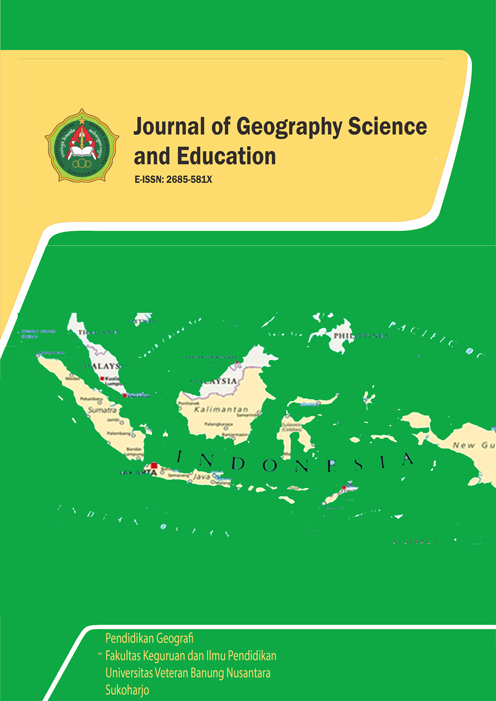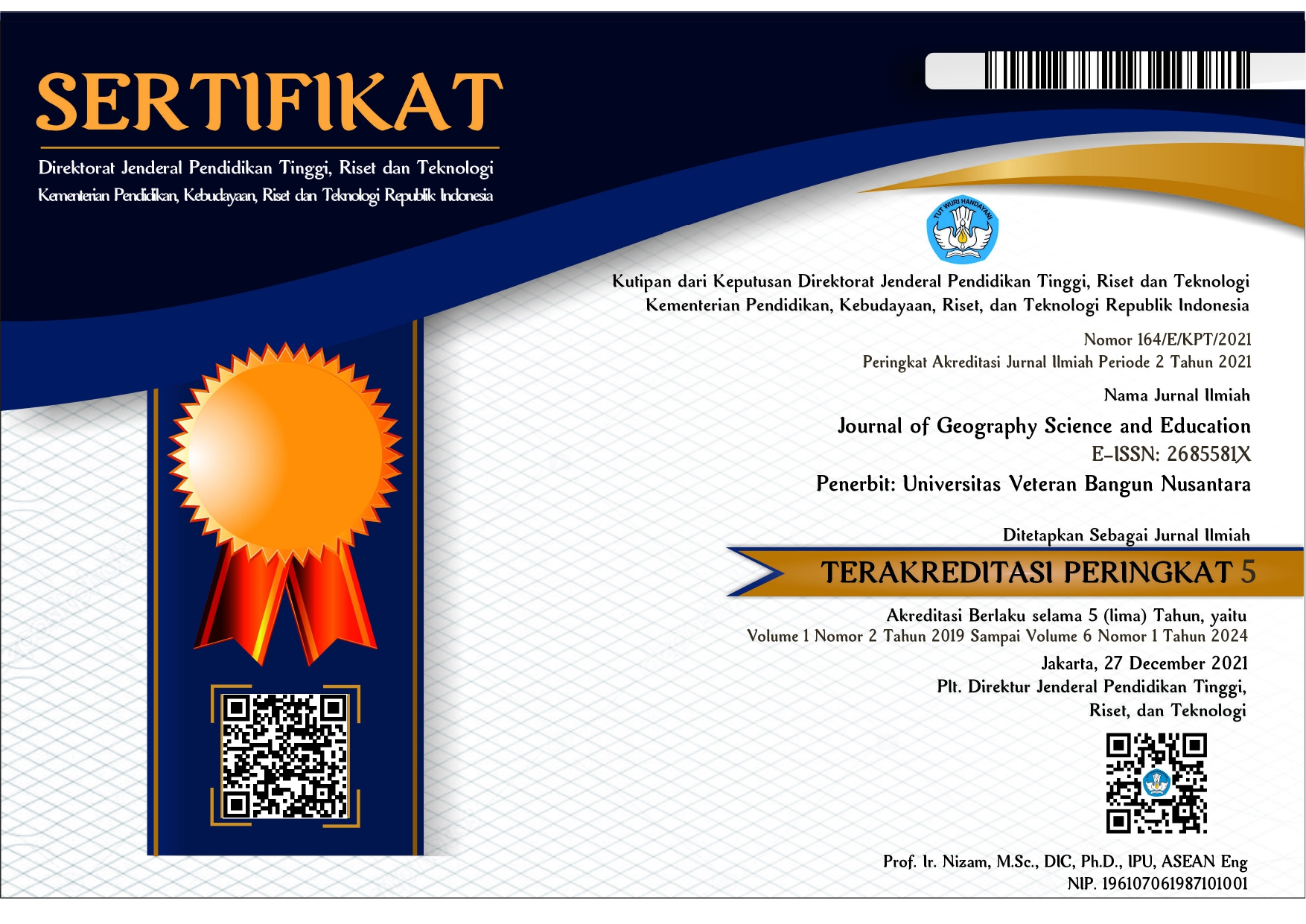Potential Analysis of New Hospital Locations in Tasikmalaya City Using Geographic Information Systems
DOI:
https://doi.org/10.32585/jgse.v4i1.1926Keywords:
Hospital, Location, Population Density, GIS, TasikmalayaAbstract
Tasikmalaya is one of the cities in West Java Province with a total population of 716,155 people in 2020 with a growth rate of 12.70% compared to the population in 2010. Cihideung District is the area with the largest population density of 13,202 people/km2 and Tamansari District is the area with the smallest population density of 2,083 people/km2. Meanwhile, the population density of Tasikmalaya City is around 3,887 people/km2. However, the number of existing hospitals has not increased significantly and is also unable to accommodate and reach this very large population. For this reason, it is necessary to add hospitals with strategic locations, one way to do that can be done with the help of a geographic information system. By using the descriptive-quantitative method, the existing data were analyzed using a correlation approach and depicted factually, systematically and accurately. Referring to the data from the overlay analysis, the determination of the new hospital land location should be placed in areas with high population density, these locations include the districts of Cibereum, Mangkubumi, Bungursari, and Purbaratu, as well as in the northern and southern areas of Tasikmalaya City.Downloads
References
Adji, J.U. (2019). “Distribution Pattern and Accessibility of Hospitals in Bandung City with Geospatial Information System (GIS) Applications”. Indonesian Computer University, Bandung.
Darmawan, K., Hani’ah., Suprayogi, A. (2017). “Analysis of Flood Vulnerability in Sampang Regency using the Overlay Method with Scoring Based on Geographic Information Systems”. Undip Geodetic Journal, 6 (1) : 31-40.
Hadi, P., Joewono, T., Santosa, W. (2013). “Accessibility to Health Facilities in Bandung”. Transportation Journal, 13 (3) : 213-222. https://doi.org/10.26593/jtrans.v13i3.1347.%25p
Indonesia Minister of Health. (2020). Indonesia Health Profile 2019. Jakarta : Indonesia Minister of Health
Isnawati, Jalinus, N., Risfendra. (2020). “Pedagogical Ability Analysis of Vocational High School Teachers who are Taking Teacher Professional Education with Quantitative Descriptive Methods and Qualitative Methods”. INVOTEK: Journal of Vocational and Technological Innovation, 20 (1), 37-44. https://doi.org/10.24036/invotek.v20i1.652
Mirzaqon, A., Purwoko, B. (2018). “Literature Study on The Theory and Practice of Expressive Writing Counseling”. BK UNESA Journal, 8 (1) : 1-8.
Moleong, L. (2002). Qualitative Research Methods. Bandung : Remaja Rosdakarya.
Mongkaren, S. (2013). “Facilities and Service Quality Influence on User Satisfaction at Manado Adventist Hospital”. EMBA Journal, 1 (4), 493–503.
Natsir, A.W.P., Setiawan, I., Somantri, L. (2021). “Analysis of Determining the Location of a New Type C Hospital Using the Analytical Hierarchy Process (AHP) Method in Sumedang Regency”. LOSARI : Journal of Urban and Settlement Architecture, 6 (1), 55–71. https://doi.org/10.33096/losari.v6i1.268
Nugraha, Y., Nugraha, A., Wjiaya, A. (2014). “Utilization of GIS to Determine Potential Locations for Development of Housing and Settlement Areas (Case Study of Boyolali Regency)”. Undip Geodetic Journal, 3 (4) 50-59.
OECD (2020). Hospital Beds Indicator. Accessed on 30 Mei 2021, From : https://data.oecd.org/healtheqt/hospital-beds.htm.
Prahasta, E. (2009). Geographic Information Systems: Basic Concepts of Geodesy & Geomatics Perspective. Bandung : Bandung Informatika
Purnomo, S., Subiyanto, S., & Nugraha, A. L. (2017). “Analysis of the Potential for Hospital Land Use Assessed from the Physical Aspects and Population Needs with Geographic Information Systems in the City of Semarang”. Undip Geodetic Journal, 6 (4), 226-235.
Radliya, R.N., Hadiana, A., Afrianto, I. (2017). “Hospital Management Information System Audit (Case Study at Tasikmalaya City Hospital)”. Journal of Governance and Information Technology Framework, 4 (1), 114-226. https://doi.org/10.34010/jtk3ti.v1i2.295
Rahmadhani, N., Suprayogi, A., Sabri. (2013). “Analysis of the Accessibility of Tsunami Evacuation Shelters in Padang City Based on Geographic Information Systems”. Undip Geodetic Journal, 2 (1) : 1-11.
Stevany, D., Suprayogi, A., Sukmono, A. (2016). “Mapping the Evacuation Path of Mount Raung's Eruption with Network Analysis Method”. Undip Geodetic Journal, 5 (4), 91-100.
Supriyanto, Y. (2012). “Analysis of the Effect of Service Quality, Price, and Facilities on Outpatient Satisfaction at Kariadi Hospital Semarang”. Diponegoro Journal of Management, 1 (4), 472-480.
Tasikmalaya City Central Bureau of Statistics, (2020). Tasikmalaya Regency in 2020 Figures. Tasikmalaya : Tasikmalaya City Central Bureau of Statistics.
Thabrany, H. (2021). Roadmap Towards National Health Insurance 2012-2019. Jakarta : National Social Security Council.
Downloads
Additional Files
Published
How to Cite
Issue
Section
License
Authors who publish with the Journal of Geography Science and Education agree to the following terms:
- Authors retain copyright and grant the journal the right of first publication with the work simultaneously licensed under a Creative Commons Attribution License (CC BY-SA 4.0) that allows others to share the work with an acknowledgment of the work's authorship and initial publication in this journal.
- Authors are able to enter into separate, additional contractual arrangements for the non-exclusive distribution of the journal's published version of the work (e.g., post it to an institutional repository or publish it in a book), with an acknowledgment of its initial publication in this journal.
- Authors are permitted and encouraged to post their work online (e.g., in institutional repositories or on their website) prior to and during the submission process, as it can lead to productive exchanges, as well as earlier and greater citation of published work.










